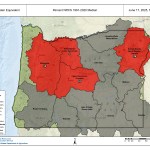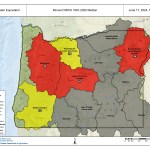Dry today, drought tomorrow: Oregon faces strains on summer water supply
Published 5:46 pm Wednesday, June 18, 2025





The amount of water stored in Mount Hood’s snowpack looked great earlier this year, as hydrologists were lauding 2025 as the first time in eight years that the entire state had been drought free since April 1.
But that earlier optimism has all but dried up.
Conditions in May revived the early signs of drought in Oregon with abnormally dry and moderate conditions already hitting the Northwest region.
USDA Hydrologist Matt Warbritton said conditions fared better in 2024 because of late season snow, but this year there has been snow melt in the central Cascade region because of warmer temperatures and a disappointing amount of precipitation.
“Overall what we’re seeing is an earlier melt out this year,” Warbritton explained. “And, overall, just really poor lower elevation snowpack throughout much of the Mount Hood region this year and Clackamas. The Bull Run Watershed, as an example, melt out at those three stations was more than two weeks early this year. So, some pretty significant early melt out, which has of course led to degradations in the water supply outlook as we moved through spring and into the start of the meteorological summer on June 1.”
As of April 1, the Hood, Sandy, Lower Deschutes region’s snowpack snow water equivalent (SWE) was measuring at 91% of normal. By June 1, that reading was around 51% of normal. As of June 17, it had degraded further to 3% of normal, which is 72% less than it was this time last year.
This time last year, the water supply outlook hung around slightly below to near normal conditions, while this year it has mostly been below normal.
“The outlook really started to degrade after the May 1 forecast,” Warbritton said. “I noted that in April we saw poor precipitation, mostly well below normal. In May, the Hood region did better than other parts of the state in terms of precipitation over the course of the month, ranging from slightly below to near normal, but still many stations recorded below normal for May, which again led to a further degradation in the water supply outlook.”
In winter, Warbritton and his colleagues did have slightly more hope for a summer of less severe drought conditions, but now he says “you can definitely expect some strain on water resources.”
“We’ve already seen drought expansion,” he explained, with both Multnomah and Clackamas Counties split between abnormally dry and moderate drought conditions, as reported by drought.gov. “We’re seeing increasingly dry areas in the state.”
“As we head into summer, certainly drier conditions have been a bit more prevalent across the region,” he added. “And, of course this time of year, we don’t receive a lot of precipitation. But early in the summer and late spring, that precipitation does help elevate stream flows a bit. We’re simply really not seeing a lot of precipitation, and certainly in terms of seasonal outlook, that’s not the greatest.”
That said, in the coming weeks, Warbritton did note that forecasts are calling for some chances at cooler temperatures and some precipitation. But he’s not entirely optimistic that the conditions will remain favorable for long.
“Cooler temperatures definitely help; they lower the evaporative demand in the atmosphere,” he explained. “And also just normal precipitation. For many areas that just means a couple to a few tenths of an inch. But that can be really important. In areas that are already seeing moderate drought now, it’s really going to take above normal precipitation, especially this time of year, to really alleviate some of those drier conditions.”
Aside from a strain on water supply, Warbritton noted that with drier conditions comes the greater potential for wildfire risk.
Fire season has already begun in Oregon, with the Rowena Fire sparking June 11, three miles northwest of The Dalles in Wasco County and already claiming several homes and burning 3,636 acres as of June 17.
“Without any really significant, above normal precipitation during this period, you can really expect those drier conditions to be pretty persistent and the water supply outlook to be pretty poor,” Warbritton said. “When we talk about dry conditions, we also have to talk about wildfire risk. Areas in moderate drought or areas that have seen below normal precipitation, especially going into summer, are at a heightened risk of wildfire. It definitely pays to pay attention to wildfire forecasts.”










